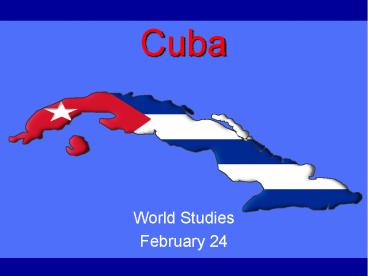Cuba - PowerPoint PPT Presentation
Title:
Cuba
Description:
Cuba World Studies February 20 I. Background Monroe Doctrine (1823): US stated the American continents were no longer open to colonization by European powers. – PowerPoint PPT presentation
Number of Views:258
Avg rating:3.0/5.0
Title: Cuba
1
Cuba
- World Studies
- February 24
2
I. Background
- Monroe Doctrine (1823) US stated the American
continents were no longer open to colonization by
European powers. - Roosevelt Corollary (1904) US claims
international police power in the Western
Hemisphere
3
- Cuba remained a colony of the Spanish until 1898
- It was Spains most important source of sugar
- People kept trying to expel the Spanish from the
island with little success
4
II. U.S. Involvement
- Many people in the US identified with the Cubans
and their fight for independence - Americans did business in Cuba
- Americans had plantation, factories and
warehouses - US bought most of its sugar from Cuba
5
III. Spanish-America War
- February 15, 1898 US battleship the USS Maine
mysteriously blows up in Havana Harbor - US quickly blames Spain
- April 24, 1898 the US and Spain will go to war
with each other - War lasted 5 months, in the end the US won Cuba,
Puerto Rico, the Philippines, and Guam
6
- Cuba gained independence in 1898 with help from
the US - Independent, but under the influence of the
- US
- - US troops would remain there until 1901 forcing
Cuba to accept the Platt Amendment
7
IV. The Platt Amendment
- In 1901 the US agreed to remove troops if Cuba
agreed to following conditions - 1. Will not lease land to anyone but the US
- 2. Will not borrow money from anyone other than
the US - 3. Will not make treaties with other countries
- 4. If US feels Cubas independence is being
threatened the US can militarily intervene - 5. Had to let the US keep Guantanamo Bay as a
military base
8
- Cubans resented these restrictions
- Good Neighbor Policy will put an end to
restrictions but not the resentment of Cuban
people
9
(No Transcript)
10
V. Cuban Revolution
- American businesses owned A LOT of sugar
plantations, mills, etc in Cuba - Despite the GN policy, the US supported dictators
sympathetic to US investments - In the 1950s Fidel Castro began rallying Cubans
against the corrupt Fulgencio Batista
11
Fulgencio Batista
12
Castro at Student Protest - 1947
13
- Late 1958, Castro, Che Guevara Camilo
Cienfuegos each led forces into Cuba - Batista fled to the US
- All the world cheered
- Until
14
VI. Communism in Cuba
- Castro nationalized all foreign owned land
redistributed it to Cuban poor - Set up national health care increased education
- Life for the poor improved, but 1000s of middle
class/wealthy fled Cuba - Primarily for the nearby US
15
VII. Cubas Cold War Role
- Cuban leaders were never able to establish an
economy without selling sugar internationally - US tried to twist Castros arm with an embargo, a
ban on trade
16
- Rather than give in, Castro turned to the USSR to
buy sugar - US cut diplomatic ties in 1960
- 1961 Bay of Pigs
- US financed an invasion by 1500 Cuban exiles
- Underestimated Cuban loyalty to Fidel
- As a result it was under-manned and the US did
not provide the expected air coverage - 1100 were taken prisoner and it cost the US 53
million to ransom them - 1962 Cuban Missile Crisis

